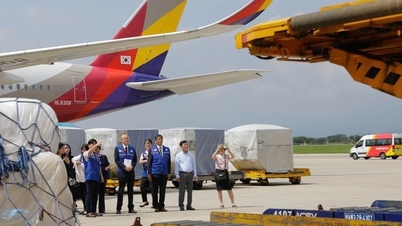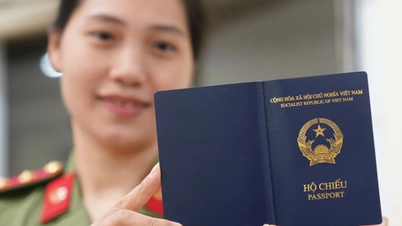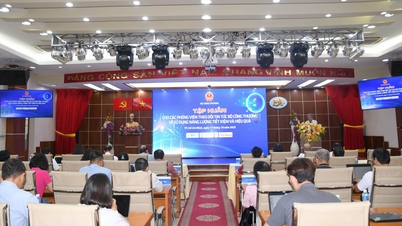Like the sinking of the Titanic, the Titan submersible tragedy is expected to change international regulations to prevent similar incidents from happening again.
After the Titanic hit a giant iceberg and sank on its maiden voyage across the Atlantic in 1912, killing more than 1,500 people, countries on both sides of the ocean seriously considered the question of what they could have done better to prevent the tragedy.
The result was the Convention for the Safety of Life at Sea (SOLAS). Adopted in 1914, the SOLAS framework remains in place today, with many of its rules building on lessons learned from the Titanic tragedy.

An undated photo shows the Titan being taken to a diving site in the US. Photo: AFP
When tragedy struck the Titan submersible during a tour of the Titanic wreck last week, killing all five people on board, experts said it was time to take a closer look at the rules governing this type of high-end adventure tourism .
When the Titanic set sail from Southampton, it was the largest ocean liner in the world , built with such advanced technology that many believed it was unsinkable.
"Not even God can sink this ship" was said by an employee of the White Star Line, the owner of the Titanic, at the time of its launch in 1911, according to the US National Archives.
The Titanic had automatic watertight doors and compartments, ensuring that any breach in the hull would not endanger the entire ship. Many also believe that the safety regulations of the time were not updated to keep up with the technology of the Titanic.
But after the tragedy, it was discovered that the Titanic did not have enough lifeboats. An investigation by the British government , where the ship sailed in 1912, found that its lifeboats had a total capacity of 1,178 people, less than 50% of the passengers and crew on board.
But under 1894 British regulations, the largest passenger ships only needed to meet a total lifeboat capacity requirement of 990 people, according to a blog post from the US Library of Congress (LOC) about the Titanic.
The post said British regulators set lifeboat capacity regulations based on the displacement of the ship, not the number of passengers on board.
The inquiry into the sinking has criticised the UK's shipping regulator, the Commerce Commission, for failing to update safety regulations.
Meanwhile, a US Senate investigation found that the US was willing to accept British safety regulations. After the Titanic tragedy, the agency required ships calling at US ports to comply with the regulations set by the country.
From there, authorities decided that an international standard needed to be established and in 1914 SOLAS was born.
"The SOLAS Convention is considered the most important of all international treaties relating to the safety of commercial ships. The first version was adopted in 1914, in response to the Titanic disaster," the International Maritime Organization (IMO) said on its website.
SOLAS was updated in 1929, 1948, 1960 and 1974 to address some of the regulatory and safety shortcomings that resulted from the Titanic disaster. It now requires that lifeboat capacity be sufficient to accommodate at least 125% of the number of passengers and crew on board.
It also sets out “minimum standards for the construction, equipment and operation of ships to ensure general safety,” according to the IMO.
Because the nearby SS Californian failed to receive the Titanic's distress signal, SOLAS required all ships to monitor emergency channels 24/7. Since 1914, authorities have also been monitoring icebergs in the North Atlantic and providing information to ships at sea.
When the Titan tragedy occurred, maritime experts and historians noted that the submersible was operating outside the scope of SOLAS regulations.
OceanGate, the company that operates Titan, said in 2019 that the submersible was safe, but that its technology was "far beyond the capabilities of regulatory agencies."
Titan also operates in international waters and flies no flag, so it is not regulated by any country, says Professor Sal Mercogliano, a maritime historian at Campbell University in North Carolina. Therefore, it does not need to comply with any country's safety regulations. "It's a gray area that has just been brought to light," he says.
“It is the responsibility of flag states to ensure that ships flying their flag comply with national requirements and hold certain certificates specified in the SOLAS Convention,” according to the IMO.
While innovators and explorers may push boundaries or even break rules to make scientific progress, many experts say there should be a higher safety threshold for paying passengers to take trips like the Titan, and a rethink of how such expeditions are governed by international rules.
"The Titanic incident more than 100 years ago changed the regulations of the maritime industry," said Danish explorer Per Wimmer. "It is very possible that the Titan tragedy will be the impetus for the world to build more regulations in the field of submarines."
James Cameron, director of the 1997 film Titanic , who has made 33 dives, recommends that anyone stepping onto a vehicle like a submersible make sure it has all government safety certifications.

The Titanic departs from Southampton, England, in 1912. Photo: Universal History Archive
“Every day we walk into an elevator and assume that someone somewhere has done the calculations correctly and they're all properly certified. We should take the same precautions with submersibles,” he said.
Cameron said he saw a link between the two disasters 111 years apart.
"The Titanic sank because the captain sailed at full speed in the ice at night, on a moonless night with very low visibility, after being warned several times," he said. "We are seeing the same thing here, with warnings about a submersible that had no safety certificate."
Vnexpress.net



![[Photo] Closing ceremony of the 18th Congress of Hanoi Party Committee](https://vphoto.vietnam.vn/thumb/1200x675/vietnam/resource/IMAGE/2025/10/17/1760704850107_ndo_br_1-jpg.webp)






















![[Photo] Nhan Dan Newspaper launches “Fatherland in the Heart: The Concert Film”](https://vphoto.vietnam.vn/thumb/1200x675/vietnam/resource/IMAGE/2025/10/16/1760622132545_thiet-ke-chua-co-ten-36-png.webp)

















































































Comment (0)